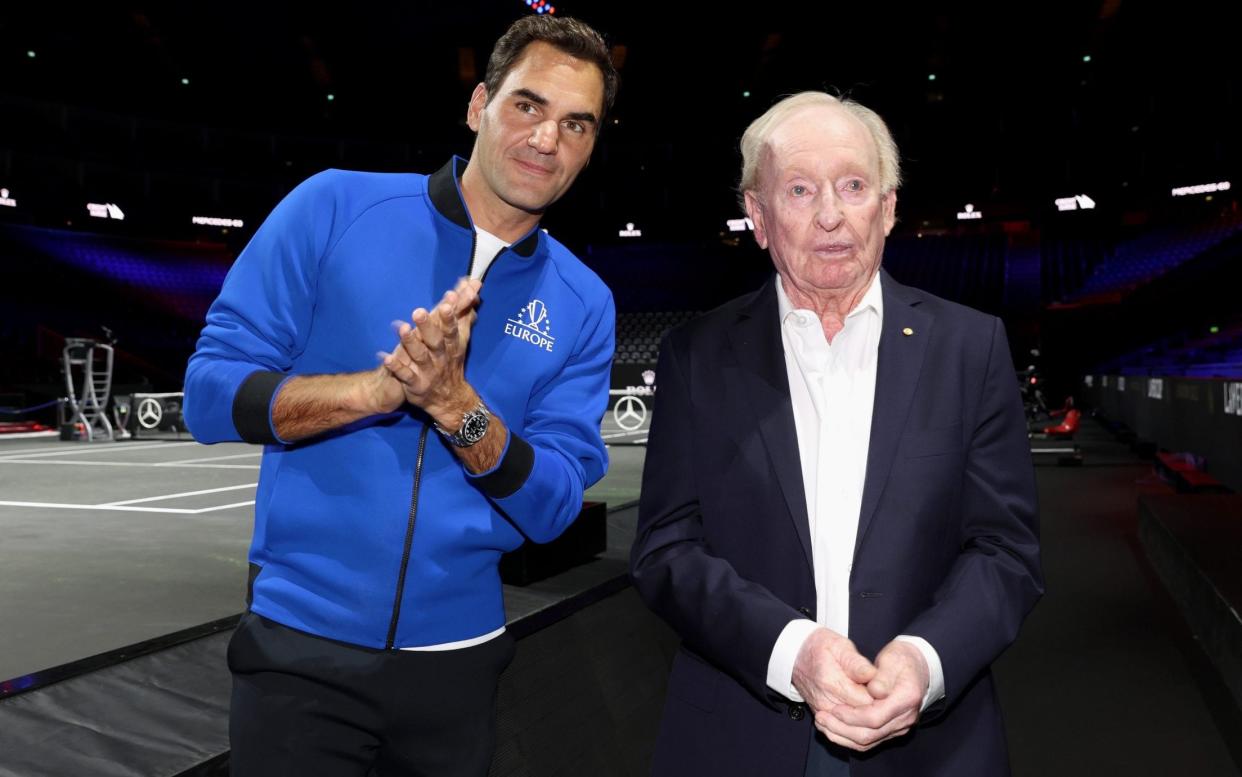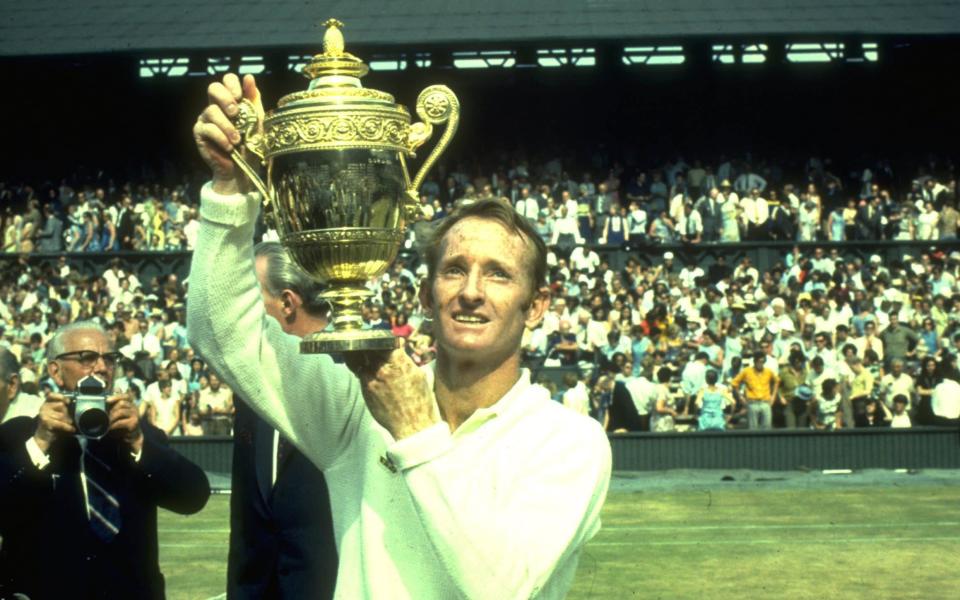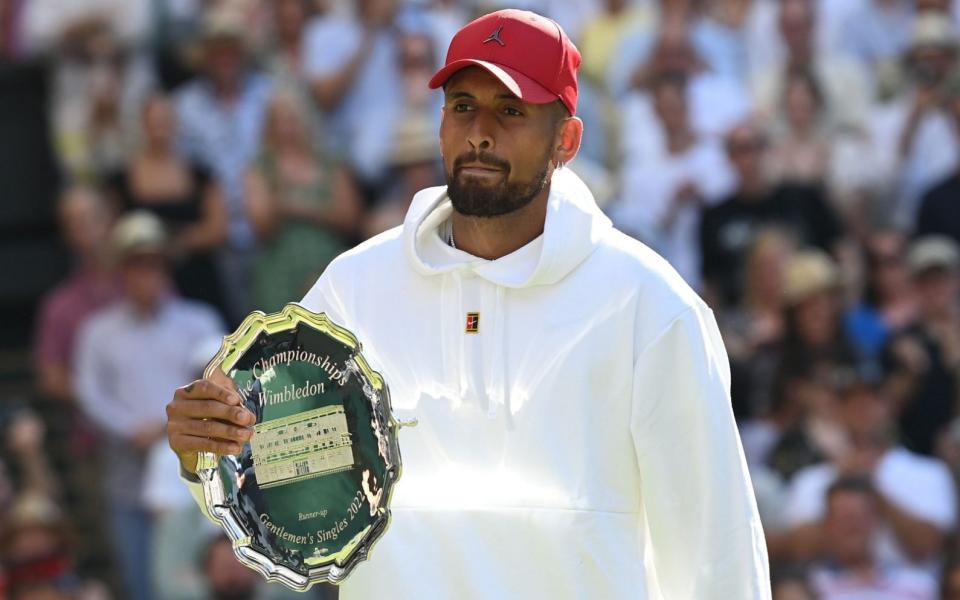Rod Laver exclusive: 'Federer could be a movie star. Kyrgios? He needs to apply himself'

- Oops!Something went wrong.Please try again later.
- Oops!Something went wrong.Please try again later.
- Oops!Something went wrong.Please try again later.
- Oops!Something went wrong.Please try again later.
- Oops!Something went wrong.Please try again later.
- Oops!Something went wrong.Please try again later.
There is still one figure in sport by whom even Roger Federer is starstruck. At 84, Rod Laver inhabits the most rarefied realm, his status as the only player ever to achieve a calendar grand slam twice establishing him within tennis as “Rod the God”. A sense of his eminence is evident at the very moment of meeting him. Here at Greenwich’s Intercontinental Hotel, as Stefanos Tsitsipas poses for selfies in the lobby and Bjorn Borg grabs a late breakfast with his wife Patricia, a setting has been laid for this interview behind a VIP rope.
It is unusual for Laver to grant such an audience. After all, his reputation precedes him to the extent that he can elevate any tournament simply by turning up. As Federer told him, amid all the weepy theatre of his farewell at the O2 Arena next door: “Thank you for always being there.” Federer, by his own admission, worships Laver. He cried on his shoulder when “Rocket” handed him the Australian Open trophy in 2006. A decade later, he coined the Laver Cup, the game’s ritziest team event, in his honour, heralding his idol as “for me, the greatest of all time”.
“I’m proud that he feels that way about past champions,” says Laver, now a close friend of Federer’s. “Roger and I hit it off immediately – this connection was something that we both wanted. He’s so wide open as a character, I can still remember our first meeting. Tony Roche, my old rival, had been coaching Roger on volleying mechanics. At this stage, he was still a baseliner, but Tony felt that he wanted to go to the net more often. He also thought that the two of us should be introduced, but at the trophy presentation in Melbourne, Roger broke down. It has been amazing to see how everything has unfolded since then.”

Few moments have left more indelible a mark than Federer’s heartrending goodbye beside the Thames, which reduced the retiring icon to such a blubbering wreck that he needed to hold Rafael Nadal’s hand for comfort.
“Not too many people retire like that,” Laver says. “I played Bjorn Borg when I was 38. I didn’t announce that it was my retirement, but it was obvious that I was coming to the end. Roger had such a long, successful career, he knew he wanted there to be something where he said clearly, ‘OK, that’s enough.’ What he’s going to do in the future is anybody’s guess. His avenues are open everywhere. He could become a movie star.”
It is not so far-fetched a notion, given that Federer has already joined forces with Robert De Niro and Anne Hathaway to shoot adverts for Swiss tourism. But in London, it is Laver who receives the most lavish Hollywood treatment. Behind the scenes at the O2 is a VIP retreat labelled the “Rocket Club”, furnished with giant black drapes and portraits of Laver winning each of his 11 major singles crowns. Quite the billing, all told, for a man who is anything but the hubristic type. The closest he came to extolling his own virtues was after his stroke in 1998, when a US doctor asked what he did for a living. “Tennis player,” he replied, groggily. “I used to be fairly good.”
He is faintly astounded by the reverence he continues to command. It is not just that Federer has paid extravagant tribute through the Laver Cup, but that the Australian Open named their main show court after him when he was still only 60. “I assumed they were joking,” he laughs. “The fact that I was a Queenslander meant the Victorian government had to give special approval. I thought then, ‘This is getting bigger than I imagined.’”
Laver had entertained few delusions of grandeur growing up in 1940s Rockhampton, deep in the Queensland bush, where even main roads were unsealed and his hard-bitten cattle-farmer father would treat any industrial injuries himself. This absence of fuss, coupled with his natural shyness, was mirrored in his attitude to his tennis. “I let my racket do the talking,” he explains. “The way I saw it, you didn’t have to introduce yourself to people. I just hit tennis balls. Roger is a little in the same vein. He plays the game because he loves it. You can tell, in how he’ll try something quite particular until he perfects it. I did the same.
“With the racket I used, a Dunlop Maxply, you needed to have perfect timing to put the shot away. That’s why my game did well in the amateur world. Not many people could use a wooden racket with such ability. As I persevered, all of a sudden I was mastering topspin. My coach, Charlie Hollis, told me: ‘You’ll never win Wimbledon with a slice backhand. You must learn to put topspin on the ball.’ Those were the learning curves. No other lefties had learned to hit a topspin backhand. It put me at another level, that little bit higher.”

History judges him even more kindly. Today, Laver’s 198 singles titles constitute the greatest individual haul of all. In 1962, he was so unanswerably dominant that he did not merely sweep all four majors, but win 18 other tournaments besides. When, seven years later, he repeated the feat as a professional, Alastair Martin, chairman of the United States Tennis Association, said on court at Forest Hills: “I’m absolutely tongue-tied. This is your second grand slam. You might very well be the best player we’ve ever seen.”
It was never Laver’s style to have his head turned by hoopla. Even on sealing that totemic achievement, with a four-set win over Roche in the US Open final, he steered clear of any histrionics, shaking the ball-boys’ hands and quietly sipping a glass of water. Near-perfection, to his mind, was a prerequisite for the ambitions he set himself.
“In the amateur world, winning Wimbledon was the most important thing in anybody’s career,” he reflects. “That was the goal. I knew that I had to learn how to play on grass, to understand the pressure, to play all types of occasions. That’s how I improved, because of the intensity I had in myself. You’re learning footwork, you’re watching the ball a little more closely, and you have to be able to hit the middle of the racket every time, not just once in 10.”
'Nick Kyrgios didn’t think he could win Wimbledon'
Self-restraint was at the core of his character. As Federer observed, in the foreword to his memoir: “Rod conducts himself with an endearing humility.” This illustrates why he found Jimmy Connors so gratingly abrasive, and why Ilie Nastase’s obnoxious conduct, referring to Laver as “old man” across the net in their mid-Seventies match-ups, tipped him over the edge. “You’re a disgrace,” Laver raged at him in Cincinnati. “I’ll never play against you again.”
“It was all about my love of the sport,” he recalls. “Ilie was an unbelievable player, but you didn’t know anything about him. Did he enjoy playing tennis when he was young? This is where your make-up comes from. Maybe you can be bad-tempered and throw your racket around. A lot of players do. I didn’t, because I only had two to play with.”
As the arbiter of etiquette in tennis, it is intriguing to explore what Laver makes of his compatriot Nick Kyrgios, the ultimate modern racket-trasher. Over the years, you have sensed him trying to bite his tongue about this *enfant terrible*, a player who, in both deportment and temperament, is his diametric opposite. Only after one especially dramatic meltdown in 2019 did he lament: “I don’t think Nick will ever learn.” But this year, Kyrgios’ shock run to a Wimbledon final has encouraged him to temper his verdict.
“Kyrgios has all the ability in the world, every shot that you could wish to make,” Laver argues. “He’s probably one of the biggest servers in the game. He’s accurate, he can play under pressure. I was thrilled that he reached the final, but he didn’t think he could win Wimbledon. In my mind, I said, ‘Hey, put in your best performance. You may surprise yourself.’ A month or two later, I said, ‘You can win some of these matches. Why don’t you apply yourself, man?’
“It hit home for him, I think. He realised, “S---, I am good enough, I can do this.’ That was the greatest thing that happened to him. Unfortunately, he said that he wanted to go back to Australia and not play in the Laver Cup. But he knows that he can play and compete now. Don’t walk on the court thinking, ‘If I get three games, that’s enough.’ Now he’s thinking, ‘Next year? Wimbledon? You’re going to see a different player.’”

In terms of mental strength, the attribute that Kyrgios has struggled to acquire, Laver set the gold standard. Hollis was the most exacting of taskmasters, ensuring not just that his star pupil had exemplary form but that he never fell hostage to complacency. Even on his slam for the ages 53 years ago, his mentor sent the message: “Congratulations. Now do it again.” This psychological steel, according to Laver, was a vital element of his supremacy. “In the amateur ranks, Roy Emerson was the only one who was going to beat me. I had to join the pros’ world at the bottom, and I understood that I would have to tidy my game up, to play with zero errors. I showed I was capable of doing that.”
For this generation of greats in the men’s game, emulating Laver as “the slammer” has proved elusive. Federer won three majors in three separate seasons but never four. Nadal’s tilt this year remained on course until the Wimbledon semi-finals, where injury thwarted him. Novak Djokovic’s near-miss was the most agonising of all, with the Serb denied at the death in New York by Daniil Medvedev. Laver, watching that day inside Arthur Ashe Stadium, had seen it all before.
“In 1956, Lew Hoad was on the last leg of his own grand slam,” Laver recalls. “I was 18. He had it all on his racket at the US Open, ready to complete it. When he was playing at his best, there was nobody near him. Unfortunately, Lou was thinking, ‘Oh, I’ll just go out there and play as well as I can.’ I thought, ‘No, you’ll go out there and win the damn thing.’ He wasn’t ready to accept it. He needed more.”
“Win the damn thing”: it might as well be the epitaph for the most remorseless champion tennis has known. Beneath the guise of a kindly elder statesman, the alpha-male mentality endures. As he takes his leave, Laver smiles and shakes my hand. The grip, as befitting a man whose left forearm was famously the size of Rocky Marciano’s, is as reliably strong as ever.

